THE FIVE GENERIC COMPETITIVE STRATEGIES STRATEGY AND COMPETITIVE


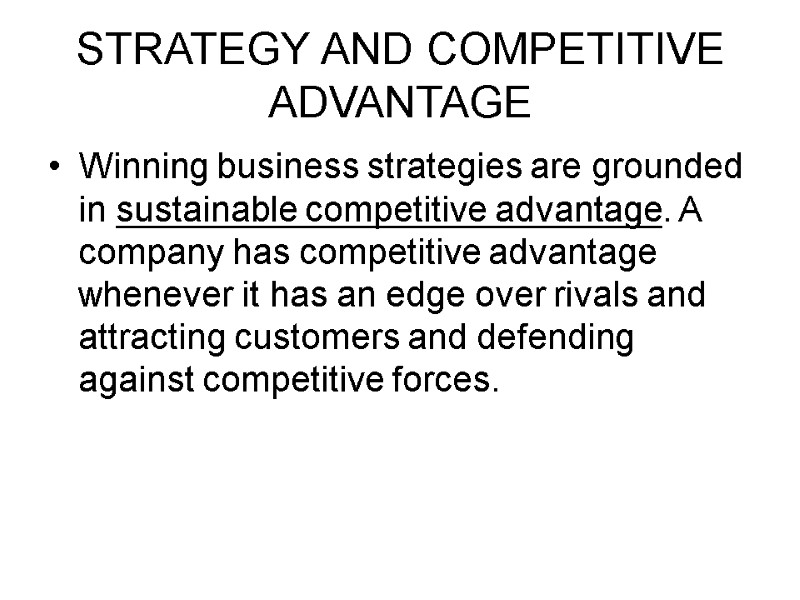
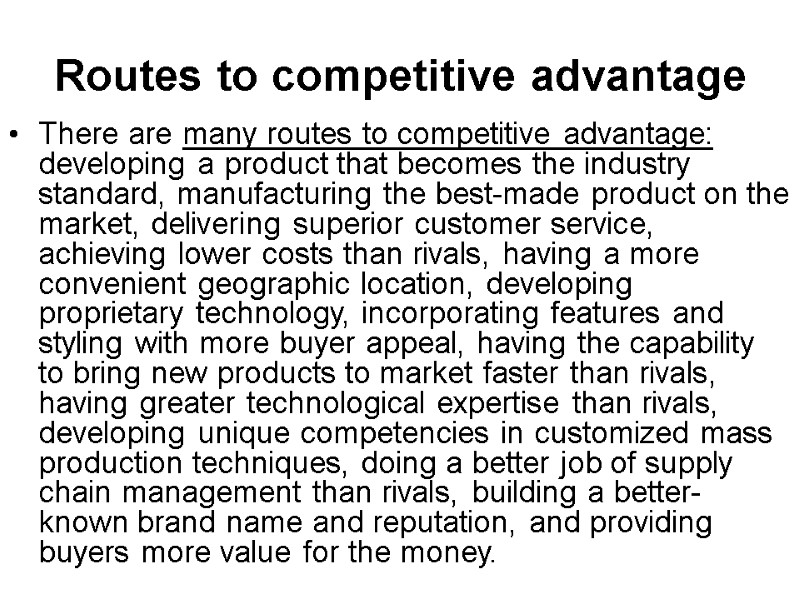
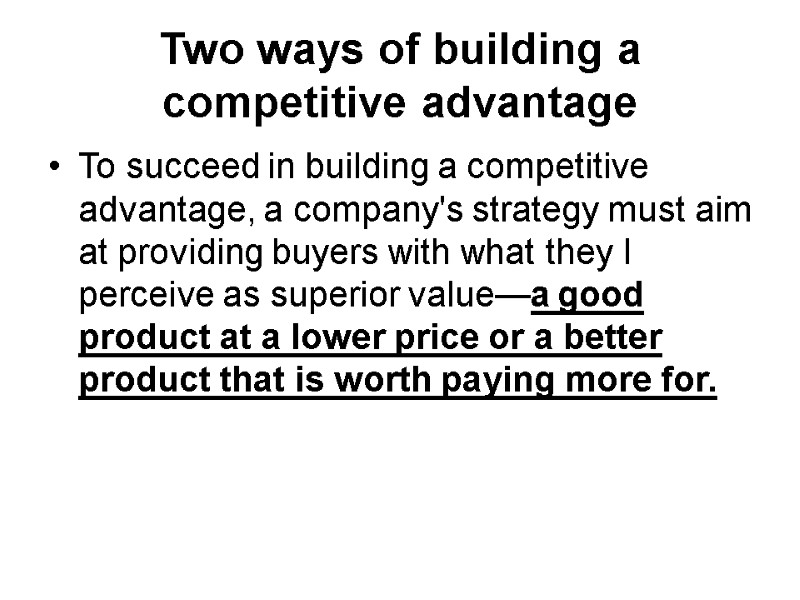
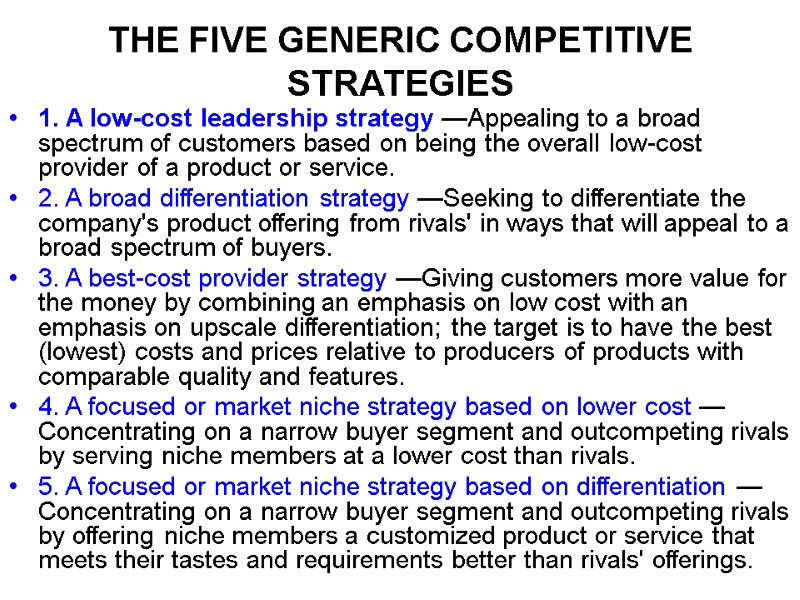
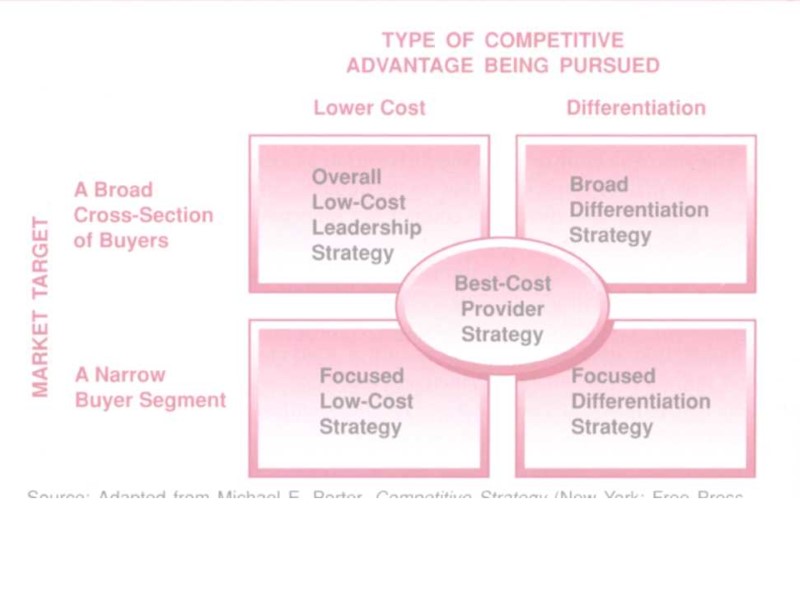

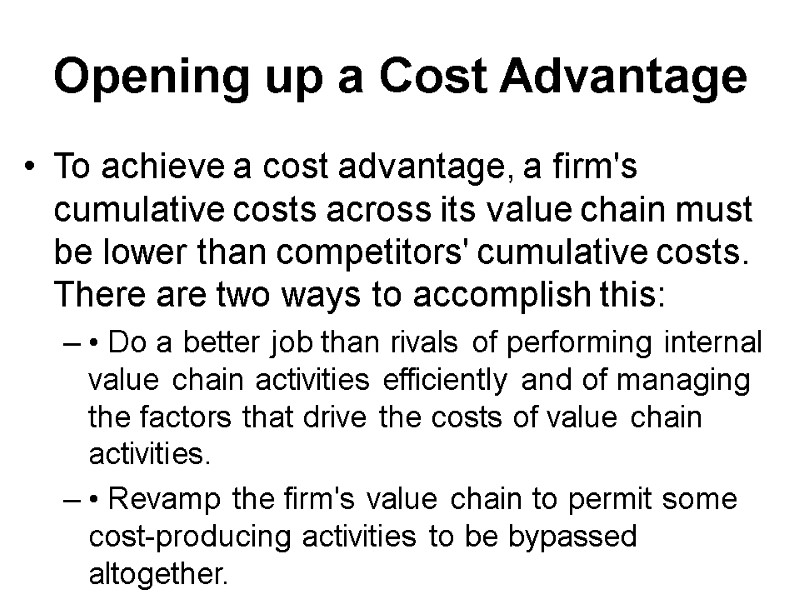
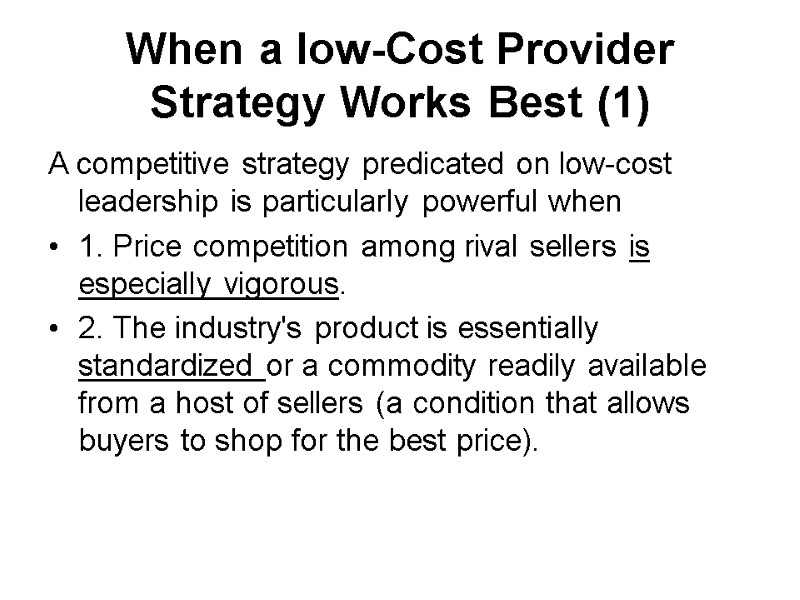
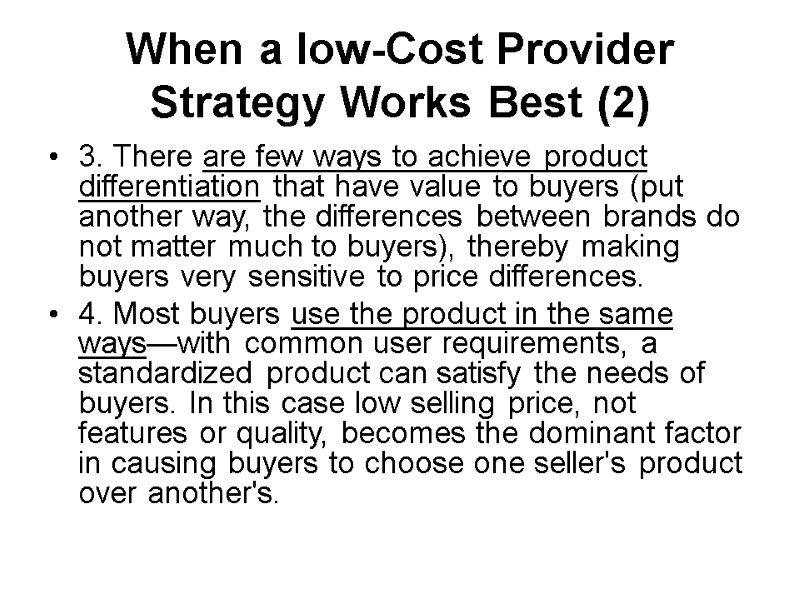
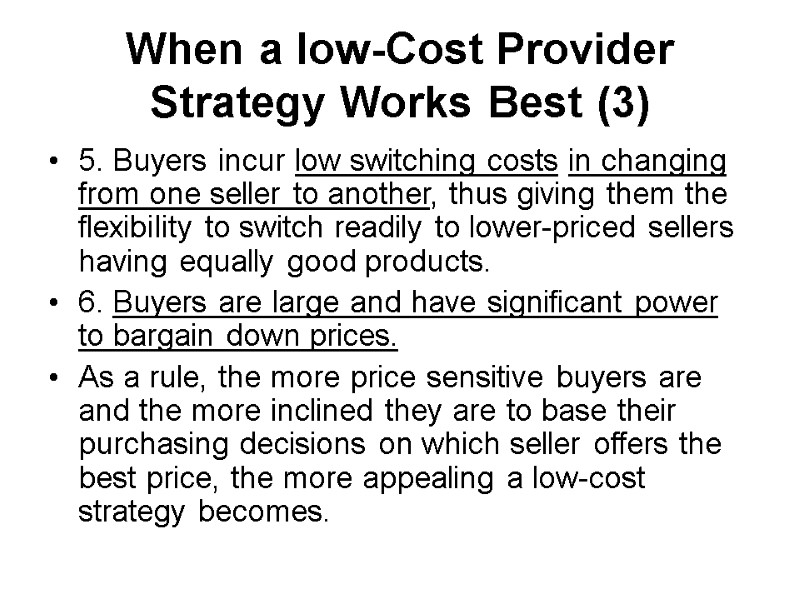
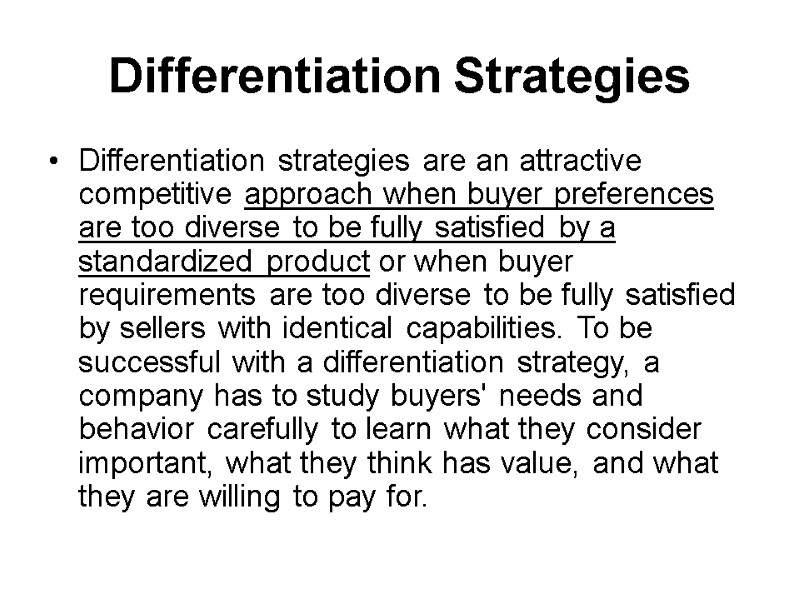


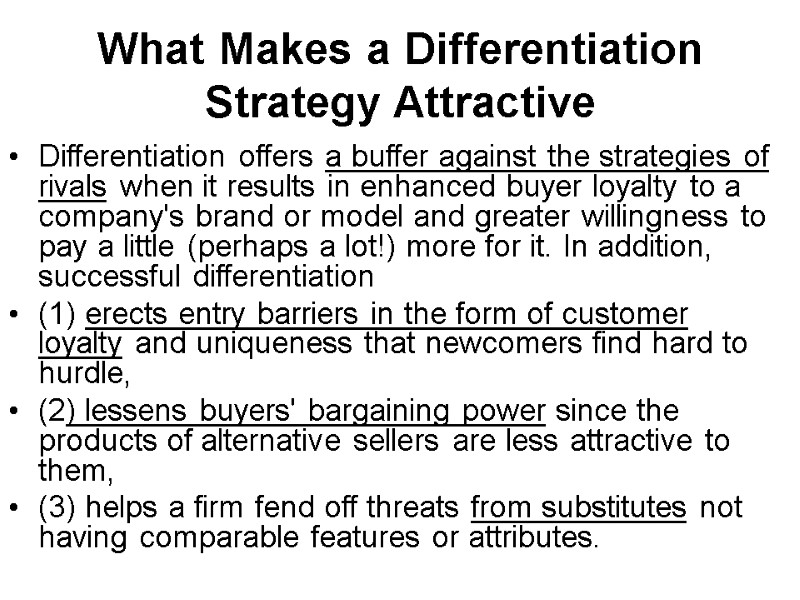
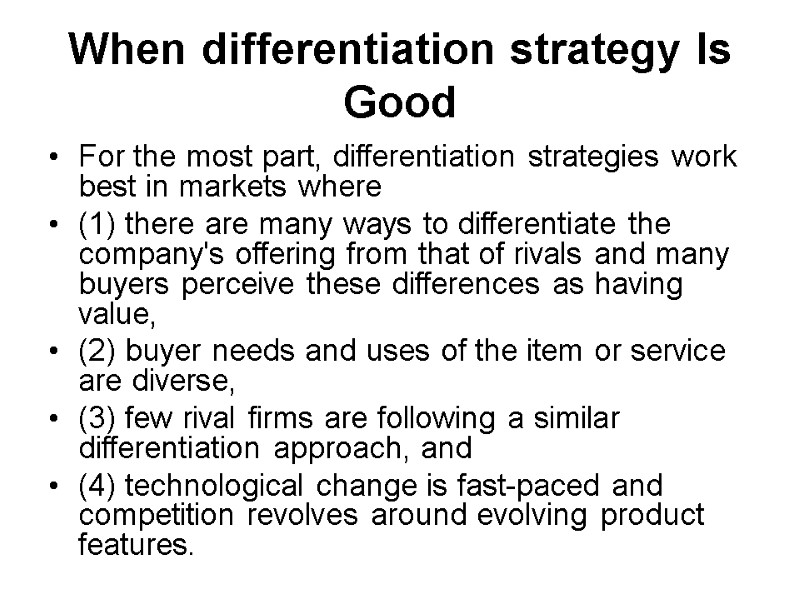
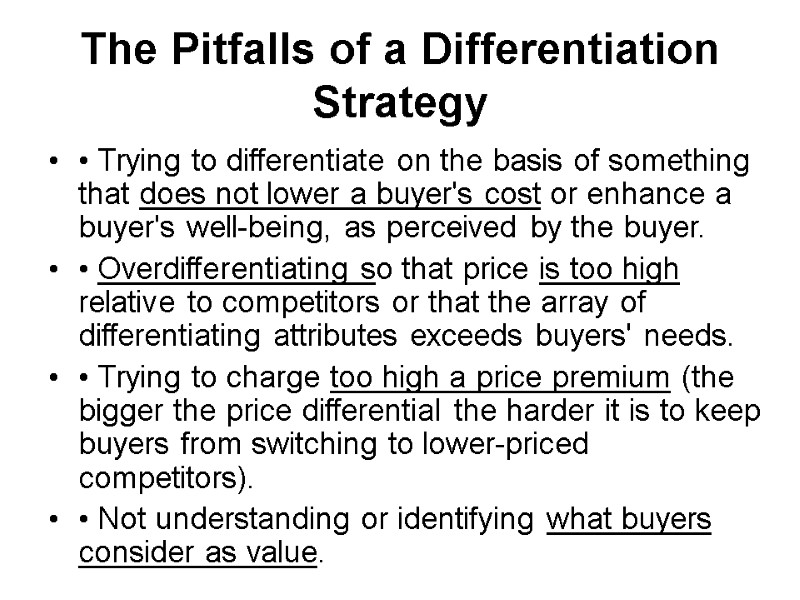
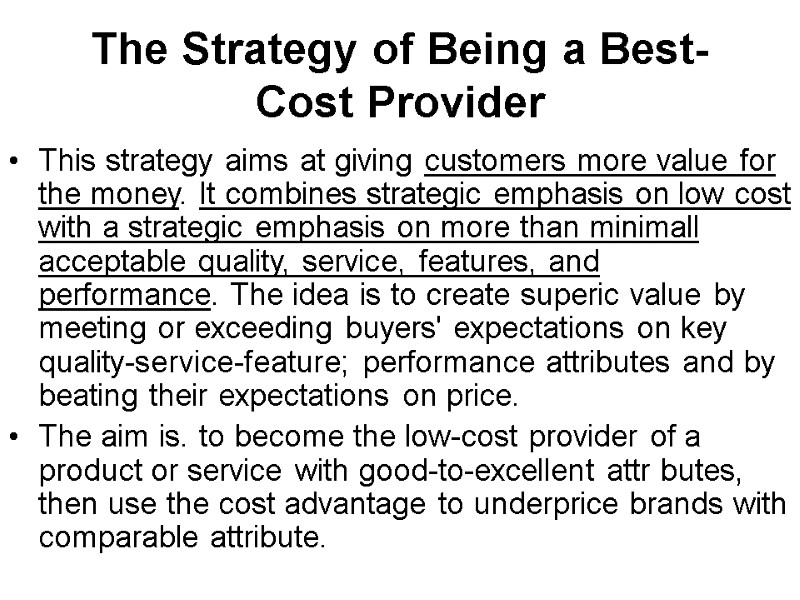
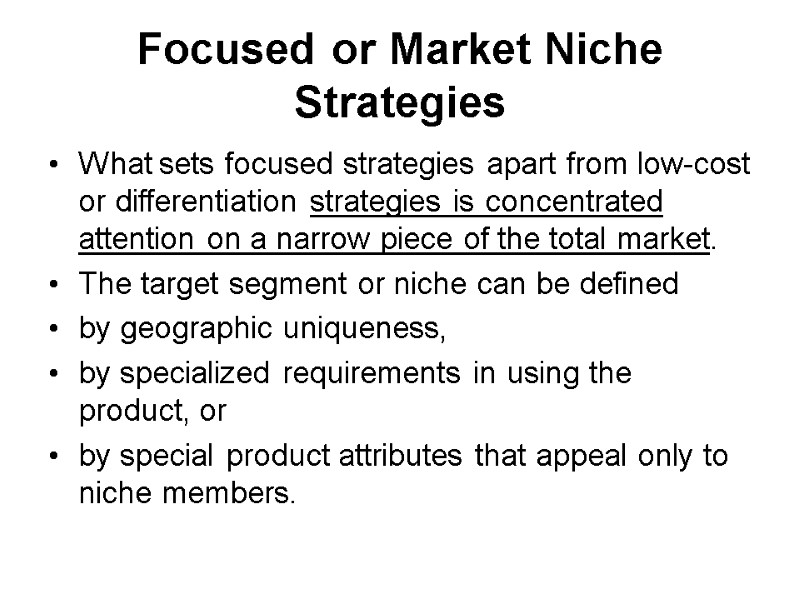
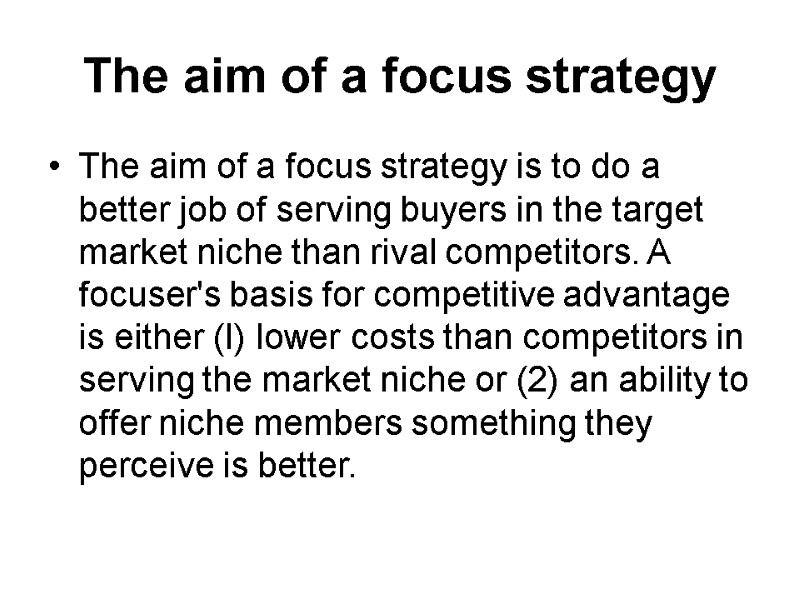
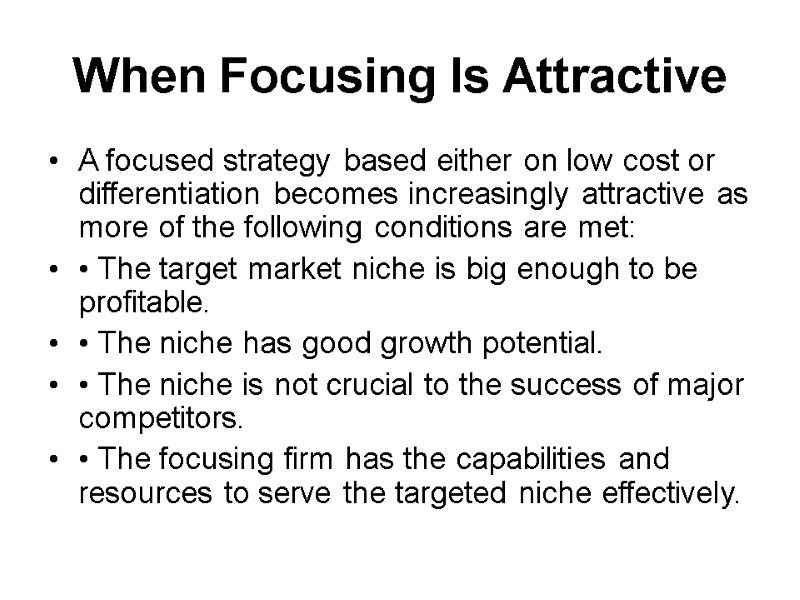
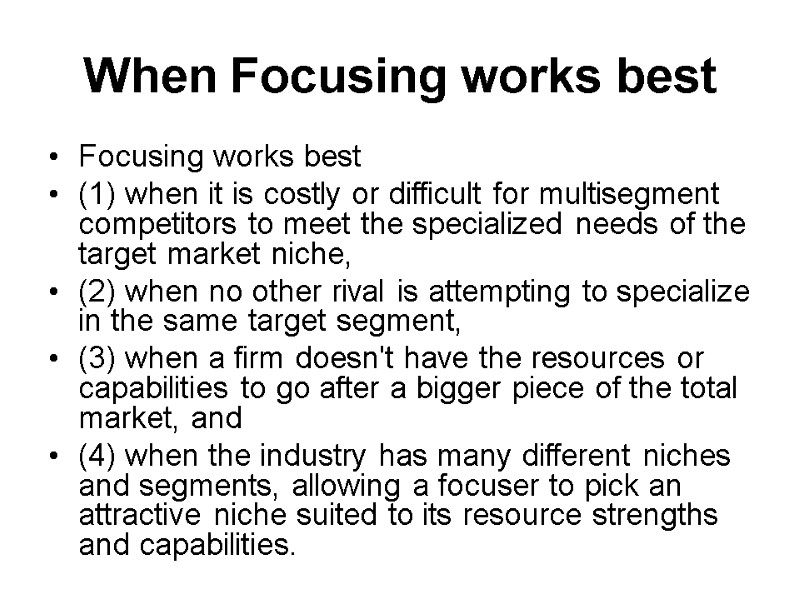
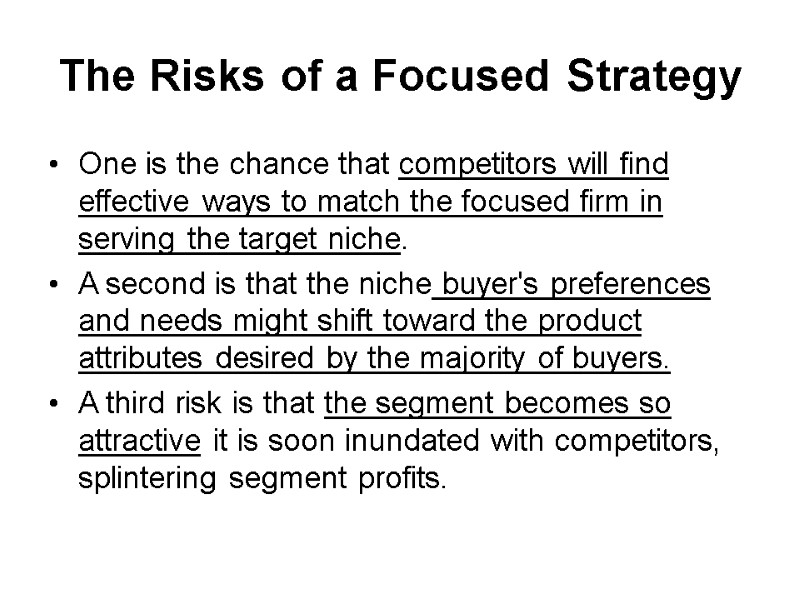
10604-lec9=the_five_generic_competitive_strategies.ppt
- Количество слайдов: 23
 THE FIVE GENERIC COMPETITIVE STRATEGIES
THE FIVE GENERIC COMPETITIVE STRATEGIES
 STRATEGY AND COMPETITIVE ADVANTAGE Winning business strategies are grounded in sustainable competitive advantage. A company has competitive advantage whenever it has an edge over rivals and attracting customers and defending against competitive forces.
STRATEGY AND COMPETITIVE ADVANTAGE Winning business strategies are grounded in sustainable competitive advantage. A company has competitive advantage whenever it has an edge over rivals and attracting customers and defending against competitive forces.
 Routes to competitive advantage There are many routes to competitive advantage: developing a product that becomes the industry standard, manufacturing the best-made product on the market, delivering superior customer service, achieving lower costs than rivals, having a more convenient geographic location, developing proprietary technology, incorporating features and styling with more buyer appeal, having the capability to bring new products to market faster than rivals, having greater technological expertise than rivals, developing unique competencies in customized mass production techniques, doing a better job of supply chain management than rivals, building a better-known brand name and reputation, and providing buyers more value for the money.
Routes to competitive advantage There are many routes to competitive advantage: developing a product that becomes the industry standard, manufacturing the best-made product on the market, delivering superior customer service, achieving lower costs than rivals, having a more convenient geographic location, developing proprietary technology, incorporating features and styling with more buyer appeal, having the capability to bring new products to market faster than rivals, having greater technological expertise than rivals, developing unique competencies in customized mass production techniques, doing a better job of supply chain management than rivals, building a better-known brand name and reputation, and providing buyers more value for the money.
 Two ways of building a competitive advantage To succeed in building a competitive advantage, a company's strategy must aim at providing buyers with what they I perceive as superior value—a good product at a lower price or a better product that is worth paying more for.
Two ways of building a competitive advantage To succeed in building a competitive advantage, a company's strategy must aim at providing buyers with what they I perceive as superior value—a good product at a lower price or a better product that is worth paying more for.
 THE FIVE GENERIC COMPETITIVE STRATEGIES 1. A low-cost leadership strategy —Appealing to a broad spectrum of customers based on being the overall low-cost provider of a product or service. 2. A broad differentiation strategy —Seeking to differentiate the company's product offering from rivals' in ways that will appeal to a broad spectrum of buyers. 3. A best-cost provider strategy —Giving customers more value for the money by combining an emphasis on low cost with an emphasis on upscale differentiation; the target is to have the best (lowest) costs and prices relative to producers of products with comparable quality and features. 4. A focused or market niche strategy based on lower cost —Concentrating on a narrow buyer segment and outcompeting rivals by serving niche members at a lower cost than rivals. 5. A focused or market niche strategy based on differentiation —Concentrating on a narrow buyer segment and outcompeting rivals by offering niche members a customized product or service that meets their tastes and requirements better than rivals' offerings.
THE FIVE GENERIC COMPETITIVE STRATEGIES 1. A low-cost leadership strategy —Appealing to a broad spectrum of customers based on being the overall low-cost provider of a product or service. 2. A broad differentiation strategy —Seeking to differentiate the company's product offering from rivals' in ways that will appeal to a broad spectrum of buyers. 3. A best-cost provider strategy —Giving customers more value for the money by combining an emphasis on low cost with an emphasis on upscale differentiation; the target is to have the best (lowest) costs and prices relative to producers of products with comparable quality and features. 4. A focused or market niche strategy based on lower cost —Concentrating on a narrow buyer segment and outcompeting rivals by serving niche members at a lower cost than rivals. 5. A focused or market niche strategy based on differentiation —Concentrating on a narrow buyer segment and outcompeting rivals by offering niche members a customized product or service that meets their tastes and requirements better than rivals' offerings.

 Low-Cost Provider Strategies Striving to be the industry's overall low-cost provider is a powerful competitive approach in markets where many buyers are price sensitive. The aim is to operate the business in a highly cost-effective manner and open up a sustainable cost advantage over rivals. A low-cost provider's strategic target is low cost relative to competitors, not the absolutely lowest possible cost. In pursuing low-cost leadership, managers must take care to include features and services that buyers consider essential—a product that is too spartan and frills-free weakens rather than strengthens competitiveness. Furthermore, it matters greatly whether the company achieves its cost advantage in ways difficult for rivals to copy or match.
Low-Cost Provider Strategies Striving to be the industry's overall low-cost provider is a powerful competitive approach in markets where many buyers are price sensitive. The aim is to operate the business in a highly cost-effective manner and open up a sustainable cost advantage over rivals. A low-cost provider's strategic target is low cost relative to competitors, not the absolutely lowest possible cost. In pursuing low-cost leadership, managers must take care to include features and services that buyers consider essential—a product that is too spartan and frills-free weakens rather than strengthens competitiveness. Furthermore, it matters greatly whether the company achieves its cost advantage in ways difficult for rivals to copy or match.
 Opening up a Cost Advantage To achieve a cost advantage, a firm's cumulative costs across its value chain must be lower than competitors' cumulative costs. There are two ways to accomplish this: • Do a better job than rivals of performing internal value chain activities efficiently and of managing the factors that drive the costs of value chain activities. • Revamp the firm's value chain to permit some cost-producing activities to be bypassed altogether.
Opening up a Cost Advantage To achieve a cost advantage, a firm's cumulative costs across its value chain must be lower than competitors' cumulative costs. There are two ways to accomplish this: • Do a better job than rivals of performing internal value chain activities efficiently and of managing the factors that drive the costs of value chain activities. • Revamp the firm's value chain to permit some cost-producing activities to be bypassed altogether.
 When a low-Cost Provider Strategy Works Best (1) A competitive strategy predicated on low-cost leadership is particularly powerful when 1. Price competition among rival sellers is especially vigorous. 2. The industry's product is essentially standardized or a commodity readily available from a host of sellers (a condition that allows buyers to shop for the best price).
When a low-Cost Provider Strategy Works Best (1) A competitive strategy predicated on low-cost leadership is particularly powerful when 1. Price competition among rival sellers is especially vigorous. 2. The industry's product is essentially standardized or a commodity readily available from a host of sellers (a condition that allows buyers to shop for the best price).
 When a low-Cost Provider Strategy Works Best (2) 3. There are few ways to achieve product differentiation that have value to buyers (put another way, the differences between brands do not matter much to buyers), thereby making buyers very sensitive to price differences. 4. Most buyers use the product in the same ways—with common user requirements, a standardized product can satisfy the needs of buyers. In this case low selling price, not features or quality, becomes the dominant factor in causing buyers to choose one seller's product over another's.
When a low-Cost Provider Strategy Works Best (2) 3. There are few ways to achieve product differentiation that have value to buyers (put another way, the differences between brands do not matter much to buyers), thereby making buyers very sensitive to price differences. 4. Most buyers use the product in the same ways—with common user requirements, a standardized product can satisfy the needs of buyers. In this case low selling price, not features or quality, becomes the dominant factor in causing buyers to choose one seller's product over another's.
 When a low-Cost Provider Strategy Works Best (3) 5. Buyers incur low switching costs in changing from one seller to another, thus giving them the flexibility to switch readily to lower-priced sellers having equally good products. 6. Buyers are large and have significant power to bargain down prices. As a rule, the more price sensitive buyers are and the more inclined they are to base their purchasing decisions on which seller offers the best price, the more appealing a low-cost strategy becomes.
When a low-Cost Provider Strategy Works Best (3) 5. Buyers incur low switching costs in changing from one seller to another, thus giving them the flexibility to switch readily to lower-priced sellers having equally good products. 6. Buyers are large and have significant power to bargain down prices. As a rule, the more price sensitive buyers are and the more inclined they are to base their purchasing decisions on which seller offers the best price, the more appealing a low-cost strategy becomes.
 Differentiation Strategies Differentiation strategies are an attractive competitive approach when buyer preferences are too diverse to be fully satisfied by a standardized product or when buyer requirements are too diverse to be fully satisfied by sellers with identical capabilities. To be successful with a differentiation strategy, a company has to study buyers' needs and behavior carefully to learn what they consider important, what they think has value, and what they are willing to pay for.
Differentiation Strategies Differentiation strategies are an attractive competitive approach when buyer preferences are too diverse to be fully satisfied by a standardized product or when buyer requirements are too diverse to be fully satisfied by sellers with identical capabilities. To be successful with a differentiation strategy, a company has to study buyers' needs and behavior carefully to learn what they consider important, what they think has value, and what they are willing to pay for.
 Successful differentiation allows a firm to • Command a premium price for its product, and/or • Increase unit sales (because additional buyers are won over by the differentiating features), and/or • Gain buyer loyalty to its brand (because some buyers are strongly attracted to the differentiating features and bond with the company and its products).
Successful differentiation allows a firm to • Command a premium price for its product, and/or • Increase unit sales (because additional buyers are won over by the differentiating features), and/or • Gain buyer loyalty to its brand (because some buyers are strongly attracted to the differentiating features and bond with the company and its products).
 Risk of Differentiation Differentiation enhances profitability whenever the extra price the product commands outweighs the added costs of achieving the differentiation. Company differentiation strategies fail when buyers don't value the brand's uniqueness enough to buy it instead of rivals' brands and/or when a company's approach to differentiation is easily copied or matched by its rivals.
Risk of Differentiation Differentiation enhances profitability whenever the extra price the product commands outweighs the added costs of achieving the differentiation. Company differentiation strategies fail when buyers don't value the brand's uniqueness enough to buy it instead of rivals' brands and/or when a company's approach to differentiation is easily copied or matched by its rivals.
 What Makes a Differentiation Strategy Attractive Differentiation offers a buffer against the strategies of rivals when it results in enhanced buyer loyalty to a company's brand or model and greater willingness to pay a little (perhaps a lot!) more for it. In addition, successful differentiation (1) erects entry barriers in the form of customer loyalty and uniqueness that newcomers find hard to hurdle, (2) lessens buyers' bargaining power since the products of alternative sellers are less attractive to them, (3) helps a firm fend off threats from substitutes not having comparable features or attributes.
What Makes a Differentiation Strategy Attractive Differentiation offers a buffer against the strategies of rivals when it results in enhanced buyer loyalty to a company's brand or model and greater willingness to pay a little (perhaps a lot!) more for it. In addition, successful differentiation (1) erects entry barriers in the form of customer loyalty and uniqueness that newcomers find hard to hurdle, (2) lessens buyers' bargaining power since the products of alternative sellers are less attractive to them, (3) helps a firm fend off threats from substitutes not having comparable features or attributes.
 When differentiation strategy Is Good For the most part, differentiation strategies work best in markets where (1) there are many ways to differentiate the company's offering from that of rivals and many buyers perceive these differences as having value, (2) buyer needs and uses of the item or service are diverse, (3) few rival firms are following a similar differentiation approach, and (4) technological change is fast-paced and competition revolves around evolving product features.
When differentiation strategy Is Good For the most part, differentiation strategies work best in markets where (1) there are many ways to differentiate the company's offering from that of rivals and many buyers perceive these differences as having value, (2) buyer needs and uses of the item or service are diverse, (3) few rival firms are following a similar differentiation approach, and (4) technological change is fast-paced and competition revolves around evolving product features.
 The Pitfalls of a Differentiation Strategy • Trying to differentiate on the basis of something that does not lower a buyer's cost or enhance a buyer's well-being, as perceived by the buyer. • Overdifferentiating so that price is too high relative to competitors or that the array of differentiating attributes exceeds buyers' needs. • Trying to charge too high a price premium (the bigger the price differential the harder it is to keep buyers from switching to lower-priced competitors). • Not understanding or identifying what buyers consider as value.
The Pitfalls of a Differentiation Strategy • Trying to differentiate on the basis of something that does not lower a buyer's cost or enhance a buyer's well-being, as perceived by the buyer. • Overdifferentiating so that price is too high relative to competitors or that the array of differentiating attributes exceeds buyers' needs. • Trying to charge too high a price premium (the bigger the price differential the harder it is to keep buyers from switching to lower-priced competitors). • Not understanding or identifying what buyers consider as value.
 The Strategy of Being a Best-Cost Provider This strategy aims at giving customers more value for the money. It combines strategic emphasis on low cost with a strategic emphasis on more than minimall acceptable quality, service, features, and performance. The idea is to create superic value by meeting or exceeding buyers' expectations on key quality-service-feature; performance attributes and by beating their expectations on price. The aim is. to become the low-cost provider of a product or service with good-to-excellent attr butes, then use the cost advantage to underprice brands with comparable attribute.
The Strategy of Being a Best-Cost Provider This strategy aims at giving customers more value for the money. It combines strategic emphasis on low cost with a strategic emphasis on more than minimall acceptable quality, service, features, and performance. The idea is to create superic value by meeting or exceeding buyers' expectations on key quality-service-feature; performance attributes and by beating their expectations on price. The aim is. to become the low-cost provider of a product or service with good-to-excellent attr butes, then use the cost advantage to underprice brands with comparable attribute.
 Focused or Market Niche Strategies What sets focused strategies apart from low-cost or differentiation strategies is concentrated attention on a narrow piece of the total market. The target segment or niche can be defined by geographic uniqueness, by specialized requirements in using the product, or by special product attributes that appeal only to niche members.
Focused or Market Niche Strategies What sets focused strategies apart from low-cost or differentiation strategies is concentrated attention on a narrow piece of the total market. The target segment or niche can be defined by geographic uniqueness, by specialized requirements in using the product, or by special product attributes that appeal only to niche members.
 The aim of a focus strategy The aim of a focus strategy is to do a better job of serving buyers in the target market niche than rival competitors. A focuser's basis for competitive advantage is either (I) lower costs than competitors in serving the market niche or (2) an ability to offer niche members something they perceive is better.
The aim of a focus strategy The aim of a focus strategy is to do a better job of serving buyers in the target market niche than rival competitors. A focuser's basis for competitive advantage is either (I) lower costs than competitors in serving the market niche or (2) an ability to offer niche members something they perceive is better.
 When Focusing Is Attractive A focused strategy based either on low cost or differentiation becomes increasingly attractive as more of the following conditions are met: • The target market niche is big enough to be profitable. • The niche has good growth potential. • The niche is not crucial to the success of major competitors. • The focusing firm has the capabilities and resources to serve the targeted niche effectively.
When Focusing Is Attractive A focused strategy based either on low cost or differentiation becomes increasingly attractive as more of the following conditions are met: • The target market niche is big enough to be profitable. • The niche has good growth potential. • The niche is not crucial to the success of major competitors. • The focusing firm has the capabilities and resources to serve the targeted niche effectively.
 When Focusing works best Focusing works best (1) when it is costly or difficult for multisegment competitors to meet the specialized needs of the target market niche, (2) when no other rival is attempting to specialize in the same target segment, (3) when a firm doesn't have the resources or capabilities to go after a bigger piece of the total market, and (4) when the industry has many different niches and segments, allowing a focuser to pick an attractive niche suited to its resource strengths and capabilities.
When Focusing works best Focusing works best (1) when it is costly or difficult for multisegment competitors to meet the specialized needs of the target market niche, (2) when no other rival is attempting to specialize in the same target segment, (3) when a firm doesn't have the resources or capabilities to go after a bigger piece of the total market, and (4) when the industry has many different niches and segments, allowing a focuser to pick an attractive niche suited to its resource strengths and capabilities.
 The Risks of a Focused Strategy One is the chance that competitors will find effective ways to match the focused firm in serving the target niche. A second is that the niche buyer's preferences and needs might shift toward the product attributes desired by the majority of buyers. A third risk is that the segment becomes so attractive it is soon inundated with competitors, splintering segment profits.
The Risks of a Focused Strategy One is the chance that competitors will find effective ways to match the focused firm in serving the target niche. A second is that the niche buyer's preferences and needs might shift toward the product attributes desired by the majority of buyers. A third risk is that the segment becomes so attractive it is soon inundated with competitors, splintering segment profits.

